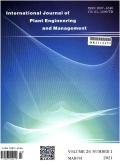A Non-Contact Ultrasonic Sensor for General Corrosion Inspection of Thin Plates
International Journal of Plant Engineering and Management
Pub Date : 2018-07-22
DOI:10.1115/ICONE26-82560
引用次数: 0
Abstract
In power plants, there are structures made up of thin plates, such as air-conditioning ducts or thin-walled pipes, where corrosion can occur. In this study, we provide a solution to reduce inspection time of the thin plate corrosion measurement and enable monitoring, using a non-contact ultrasonic sensor. The sensor can measure the reduction in thickness of thin plates due to general corrosion without the need to remove or reinstall insulating material that is on the outside of the plate. The proposed sensor is based on the non-contact ultrasonic measurement technique which was originally proposed by Greve et al, further developed and patented by Zhong et al. at the University of Bristol, and commercialized by Inductosense Ltd. In order to ultrasonically measure the thin plate thickness, we use a method based on the group velocity of the guided waves. The proposed method was tested theoretically with numerical simulations and experimentally against our target conditions. The results of the numerical simulations and experiments confirm that the proposed method can be applied to thickness measurements of thin-plates in our target condition. Based on the feasibility test results, we developed a prototype sensor and measurement software. From the results of the performance evaluation tests, we have confirmed that the prototype sensor has sufficient capability to measure the thickness of the thin plates without the removal of the insulator. Even if the offset between the plate and the inspection probe is 100 mm, the prototype sensor still works well.用于薄板一般腐蚀检测的非接触式超声传感器
在发电厂,有些结构是由薄板组成的,比如空调管道或薄壁管道,这些地方可能会发生腐蚀。在本研究中,我们提供了一种使用非接触式超声波传感器来减少薄板腐蚀测量的检测时间并实现监测的解决方案。该传感器可以测量由于一般腐蚀导致的薄板厚度下降,而不需要移除或重新安装板外部的绝缘材料。该传感器基于非接触式超声波测量技术,该技术最初由Greve等人提出,由Bristol大学的Zhong等人进一步开发并获得专利,由Inductosense Ltd公司商业化。为了对薄板进行超声测量,我们采用了一种基于导波群速度的方法。针对我们的目标条件,对所提出的方法进行了理论、数值模拟和实验验证。数值模拟和实验结果表明,该方法可用于目标条件下薄板的厚度测量。在可行性测试结果的基础上,开发了传感器样机和测量软件。从性能评估测试的结果来看,我们已经确认原型传感器有足够的能力在不去除绝缘体的情况下测量薄板的厚度。即使板与检测探头之间的偏移量为100mm,原型传感器仍然工作良好。
本文章由计算机程序翻译,如有差异,请以英文原文为准。
求助全文
约1分钟内获得全文
求助全文

 求助内容:
求助内容: 应助结果提醒方式:
应助结果提醒方式:


